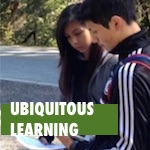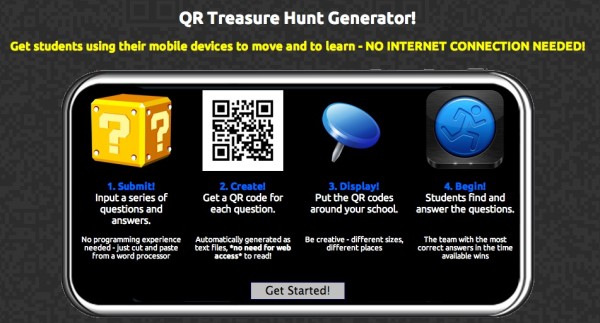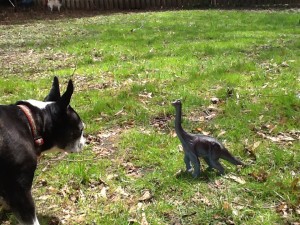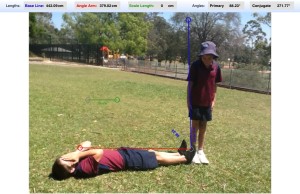Natalie Smith, a middle school science educator at Lyndon Town School, in Lyndonville VT, originally presented “Making Science Authentic: Teaching Place-Based, Decolonized Ecology in the Middle School Science Classroom” in January 2021. She presented it as part of the 2021 Middle Grades Conference at the University of Vermont.
Below please find a recording of the workshop, optimized for solo or team playback.
The workshop itself contains a number of prompts for reflection. We encourage you to listen to these materials as a solo practitioner, or with your teaching team. Additionally, we present an annotated transcript of this presentation for your use.
Recording

Audio-Only Version
Annotated Transcript
Let’s jump right in to my pet peeve.
For those of you that aren’t familiar? You are lucky. This video is The Wolves and Moose of isle Royale (video), and I’m not going to inflict it on you.
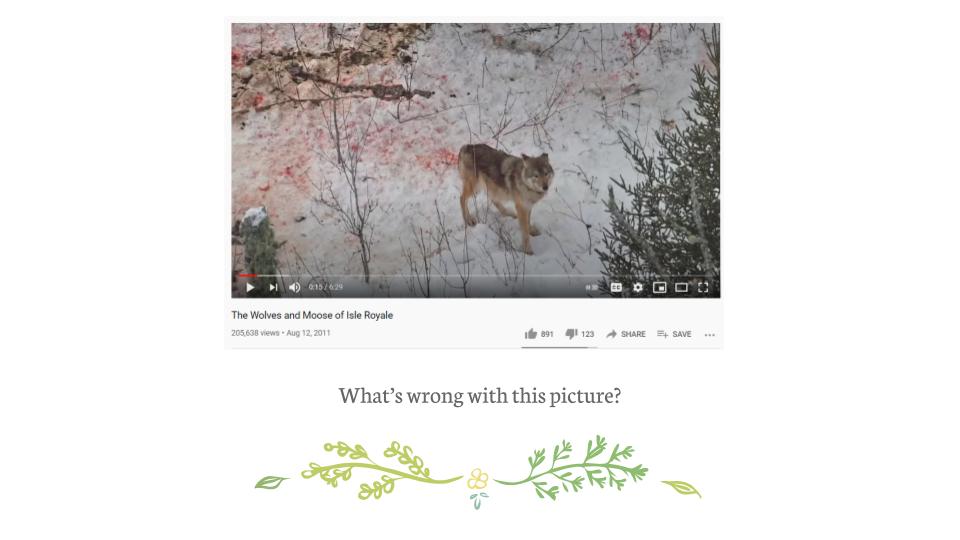
I’m being a little unfair to this video because it’s a really fascinating study in population dynamics. In how a closed ecosystem like Isle Royale — which for most of the year animals can’t come and go because it’s so far removed from the mainland — how predator and prey relationships are shaped on that island when one of those populations, the wolves, undergoes a drastic decline.
That all sounds really great to me, as a scientist. And it probably sounds really great to you if you are a science teacher. But I have a major problem with this video.
My problem is that for the past six or so years, I’ve been in and out of various science classrooms as an instructional assistant and as an intern, and every time we get into ecology, we show this video.
Every classroom I had been in, and every school that I had been in, this video has come up.
Then, I had the opportunity to start at Lyndon Town School (LTS) this year.
The previous 7th grade science teacher shared with me her old materials. And right there at the top of the unit plan there, they were again: the wolves and moose of Isle Royale. For me, they’re fascinating.
But for the past six years, I have sat there through this video and watched the faces glaze over. Because there are two groups of kids that are really into this video:
- the middle school wolf girls are really into this video (because there are wolves in it);
- and the kids who already see themselves as scientists are into this video.
And everyone else has no way of accessing science through this video.
I’m going to be honest with you: I’ve seen this video seven or eight or nine times now, and I still could not tell you on a map where Isle Royale is. I think it might be in Michigan or Minnesota or one of those other M States, but going to be honest: not a clue. Plus, I could be making that fact up.
And that’s the problem.
If I, as a science teacher, as someone who spent four years studying biology, have no connection to this video, how am I going to expect my students to connect to the subjects that I’m teaching them? If I start out with something that’s got no relevance to their lives whatsoever (unless they’re the middle school wolf girls).
So, in starting my year out at LTS, my goal was to make a significant change to how we teach ecology.
And I’m kind of fortunate that I am the only 7th grade science teacher. I am the only one in my building that is teaching ecology. So I got to say: you know what? I am not showing the wolves of Isle Royale this year. We are doing something different.
So here was my goal in this unit.
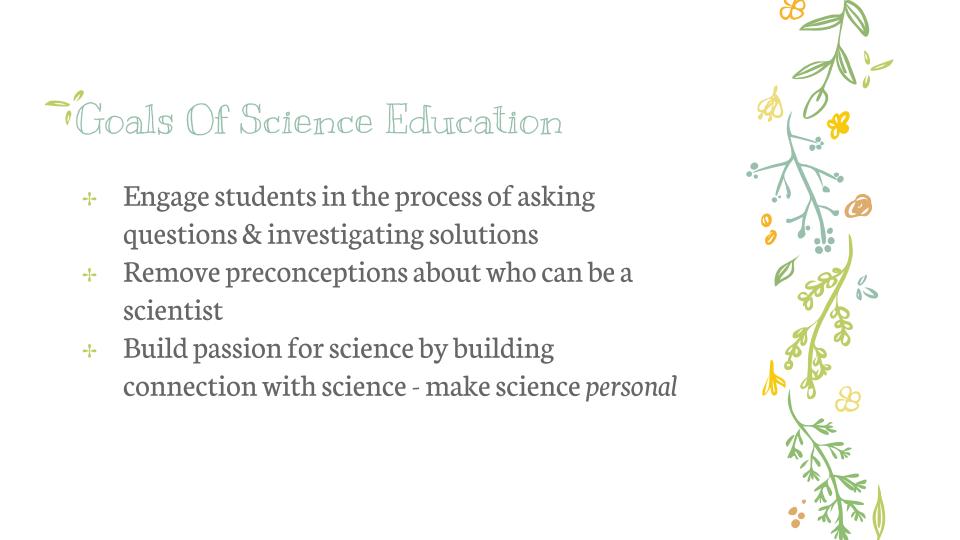
My goal was threefold.
First to get them engaged, to get them asking questions and investigating solutions by second, making them see that every single person who walks through my classroom door (or rather in COVID times, every single person who is in the room when I walk through the classroom door) is a scientist.
And to make sure that everyone who is in my classroom can see themselves reflected in the science that we’re learning.
And to do that part three, I wanted to make the science personal. By building a connection for them to the stuff that they were learning.
So here’s my mission statement. It’s beautifully phrased and you are welcome to read it, but what it boils down to is that I wanted my students to engage in the work of thinking like a scientist by making the material relevant to them. And by breaking down the idea that there is any one right way to interact with their ecosystem.
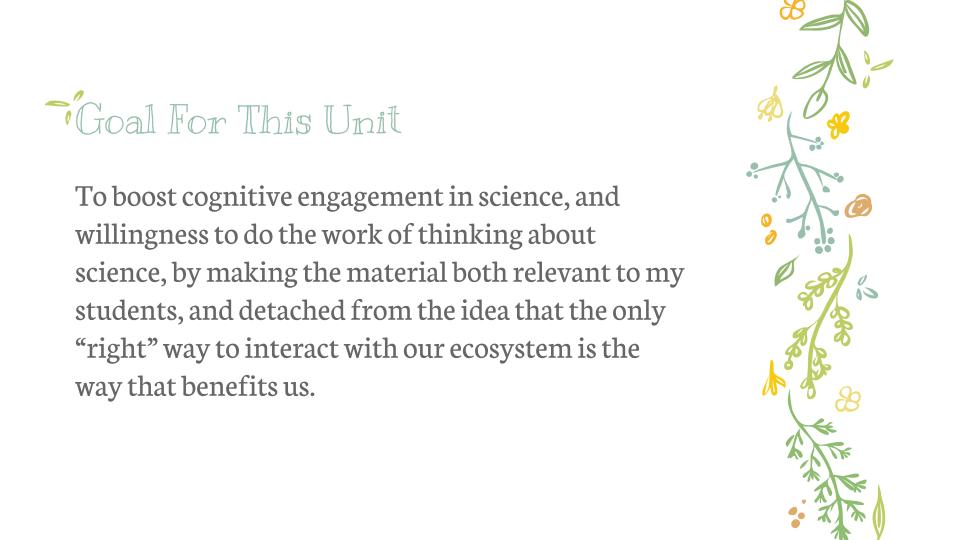
Before the unit started. I gathered some data, because I’m a scientist.
So in my traditional start-the-year survey, I snuck in a few extra questions beyond the:
- Who are you?
- And what’s your experience with science
- What are you passionate about?
- And what do you want me to know about you?
In between those, there were 10 I statements that were related to cognitive engagement, and those were around topics like:
- whether or not my students ask questions when they’re confused;
- whether or not they had strategies that they employed for understanding material;
- and whether or not they have goals for their learning;
- whether or not they talk about their material outside of my class and make connections between what they’re learning and other topics.
For these questions, I had students rank themselves from one to four, which really irked them. Because middle school students love nothing more than selecting that answer right in the middle. And they couldn’t do that.
They had to scale themselves from one to four, with one being, “Nope, this doesn’t describe me at all” and four being, “Yes, this is me overall.”
What I saw was that my students were willing to ask questions, but they were not at all engaged in making connections between science and the rest of their lives.
And I want to show you two graphs that show what is the most telling for me.
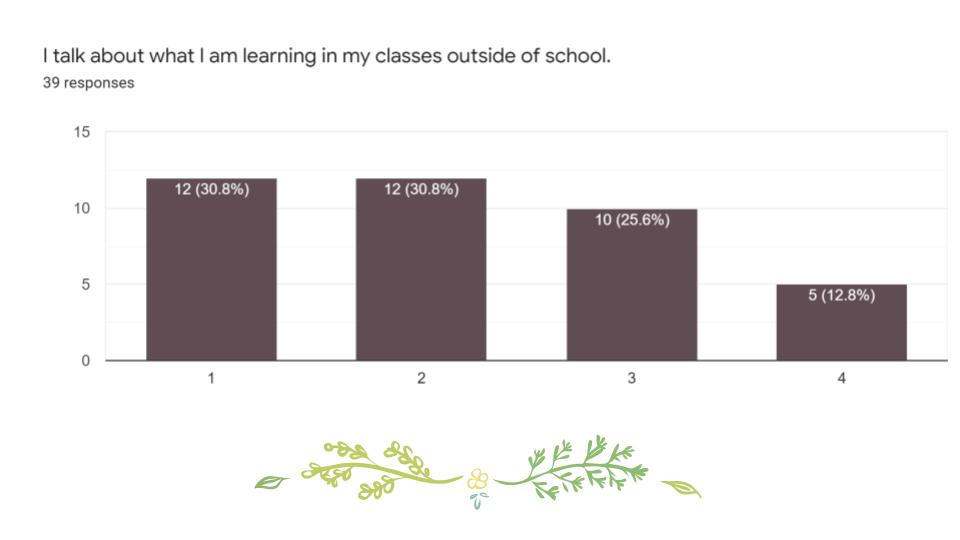
The statement that I gave them was, “I talk about what I am learning in my classes outside of school”. And over 60% of my students were in the, “that does not sound like me” range. Only 12.8% — five of my students — talk about what they are learning outside of school.
Or at least did at the start of the school year.
And the other one that was very telling for me was, “I try to make connections between the things I’ve learned.”
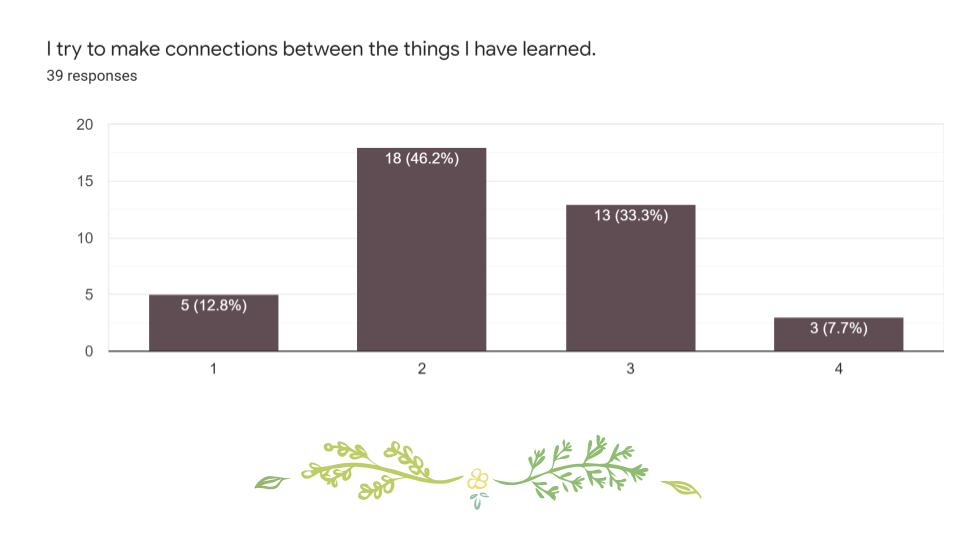
Again, more than half of them in that one to two range, and only three students saying, “Yes, this sounds like me. I make connections between the ideas that I’m learning.”
So.
The goal is to change those two sets of numbers.
And here’s where we started instead of the wolves of Isle Royale. I started with this book: Tom Wessel’s Forest Forensics, which is based off his longer book, Reading the Forested Landscape. And if you are a science teacher in Vermont, this book was made for you because this is a field guide to figuring out the history of a new England forest.
So.
I took this field guide and broke it down to make it a little more student-friendly. I turned it into some real, yes or no dichotomous keys. Where my students could take them out into the woods around our school and use them to draw a conclusion about what our school’s land was used for before 1991, when our building was built.
We spent a glorious day out, roaming the trails with dichotomous keys, hunting for pillows and cradles and inspecting trees for scar tissue and identifying insect species that we could use to determine how old the forest around us was. In order to draw a conclusion about *our* place specifically and what the history of it was before we got there.
The conclusion that my students mostly reached was that they are convinced that our school was built on an old growth forest.
Before we came to that spot, this was undisturbed forest land. Rich.
And we built on this unit from that foundation.
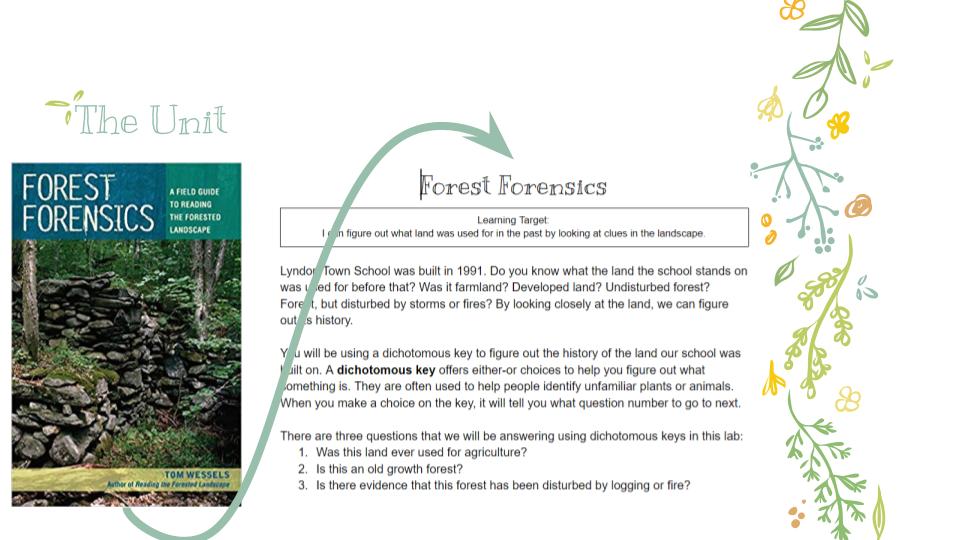
From saying, “These concepts are relevant to this spot that we are standing on.”
We can get the big vocabulary and we can talk for hours about what abiotic and biotic factors are, and what different types of symbiosis are.
But all of these things are happening here. All of these things are things that you as an individual are a part of.
From there, some of the stuff that we did in this unit?
I built in some time for them to say, here’s what I want to learn about.
Based on that, I built some playlists for them to work through around topics like water use, and agriculture. Because many of my students are farmers, they wanted to investigate that.
One of the topics that I was able to build, with some resources shared with me by Judy Dow of Gedakina, was a playlist that many of my students engaged with around traditional tribal ecological knowledge.
Based off my second book recommendation for you for the day, Low Tech by Julia Watson, we did lab work related specifically to Vermont waterways. I gave my students a map and said,
“Okay, here’s where my parents live. Here’s where we are. I’m driving between the two places. You tell me where to stop. And we’re going to test the water from those places to see, which is the healthiest. “
Lake Willoughby was the winner, and Winooski River was the loser in our lab testing. Make of that what you will.
Students chose what concepts I presented them with under the broad umbrella of ecology and ecosystems. I said, “Okay, what out of this interests you most?”
So we spent a week focused on what makes something alive, anyways. And how do scientists know if something is alive? Including the classic lesson on sewer lice.
For those of you that are about to be concerned, sewer lice are raisins in some kind of carbonated beverage. But because they are paired with this fantastic video from Carolina Biological Supply, I can convince any room of students that sewer lice are a real organism.
And then they get real grossed out when I start eating them out of the test tube.
It really generates a conversation when I finally reveal to them what the sewer lice are.
- Okay, what fooled you?
- What made you think that this was alive?
- And how is this such a hard topic for us to understand?
But the ultimate goal in this unit was to get them to here, to our final project.
Which was to say: you are a member of this ecosystem for better or worse. You are a member of your ecosystem. And because you are a human person, you are capable of making more drastic effects than any other single part of this ecosystem.
So.
You have needs as an individual. You have things that you love. How can we meet those needs? How can we fulfill those passions while still meeting the needs of our ecosystem?

Okay.
I turned them loose on identifying topics that were important to them, which ranged everywhere from art and art supplies to sports (which was terrifying for me because I am not a sports person), to farming to old cars. You name it, they loved it.
Whatever they came to me with, we worked together to identify how that topic impacted the ecosystem.
So to give one example: one of my students is an artist. And this student really wanted to do something related to art. So what we came up with was looking at art supplies and how those are made. Could we make them with better materials? So that you can still do art while not contributing to the problems of overuse of plastics?
Once they had a topic, I turned them loose on some research.
They had to come back to me with the answers to four questions.
They had to give me some background info just because I can’t be an expert in everything. And they had to tell me:
- How does this topic or issue or passion affect our ecosystem?
- What changes are possible to make?
- What are people doing already?
- And if we make these changes on a broader scale, what would the impact be on our ecosystem?
Then finally, once they had those answers, they designed some kind of a multimedia project to share what they learned. And the goal here was that they would be sharing it, not just with me, but with someone out in the community to try to affect change.
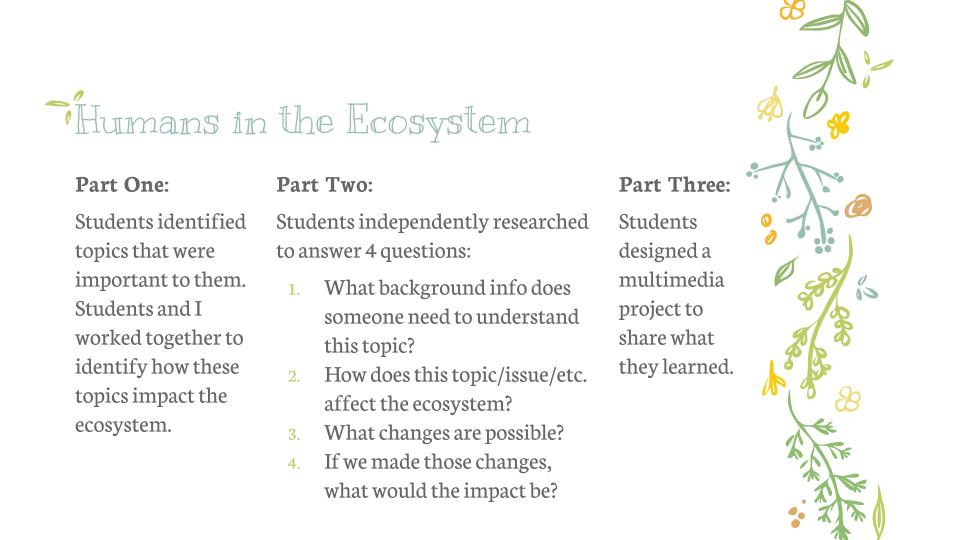
Unfortunately, the last bit of that goal was kind of the stumbling block for this unit.
I learned that 99% of seventh grade students are not willing to have their work shared with anybody but their teacher.
So, the student in this example ended up focusing in on two art supplies: ink and paintbrushes. This student identified that a major problem with art supplies is plastics and how much plastic is used to make the materials that we use to make art. This student also identified how to make their own ink. They identified how to make their own hair for the brushes. And wood-based paintbrushes to use with that ink.
The art that is on this poster was partially accomplished with the ink that this student made to demonstrate me that this was a viable alternative.
They were able to identify that not just the plastic, but the actual materials in the ink itself are bad for the environment. So that making their own ink and making their own brushes would help to mitigate the problem of plastics being tossed into a landfill.
The other outcome?
This question has come back to haunt us from the start of the presentation. I talk about the things we learn outside of school. So when asking them specifically about this unit, we started off with 60% of middle schoolers down in this one to two range Well, over 60% instead are in the two to three range, moving towards talking more about what they’re learning outside of class.
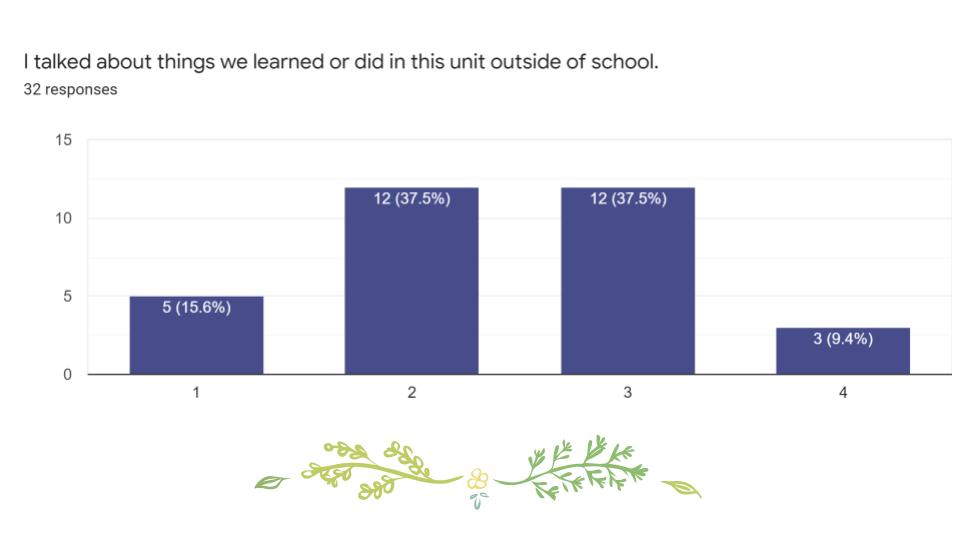
Unfortunately, this next one didn’t change as much as I would like.
The making connections between what I’m learning and other learning and outside ideas? These numbers stayed fairly consistent from the first survey to the last survey.
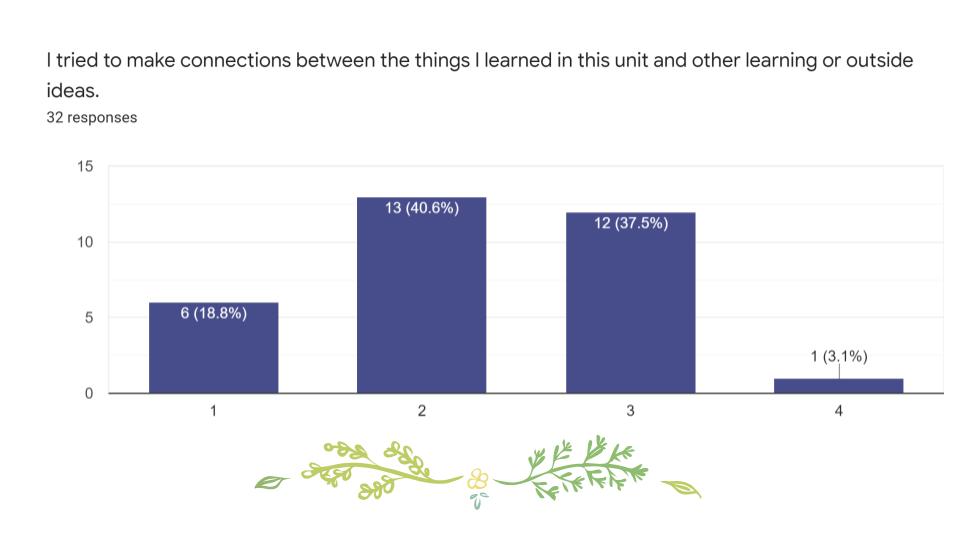
We had about 50% down in the one to two range when we started, and 50% still down there.
I think a large part of that is two-fold.
Part of that was that they did not want to make a connection to the outside because they did not want to share their work.
But the other part of that, another major stumbling block that I didn’t anticipate with this unit, was a vocal group of students who walked into this final project and informed me that they would only be doing a topic where they could say everything that we as humans are doing is right, and nothing should change.
And we’re starting to see that same group of students in the humanities. Applying those same ideas to their work around politics and history.
So part of my next step for this unit, when I teach it again in the future — I’m going to keep working on this unit – is to find a way to de-center the idea that the way we as white people in the Northeast kingdom are doing things is the right way to do things.
Part of that is that this unit needs more connection to the Wabenaki people, whose land I am teaching on right now.
And part of this unit that would exist if these were not COVID times would have been an excursion into Vermont’s returned tribal forest plains. They’re right up the road from our school, but too far away for us to get to on foot. We were not able to travel to them this year.
And then in the future, I want all of my units to eventually be viewed through this lens.
So all of my science units at someday are going to start with:
- How do I connect these people that live here to this concept?
- Why does what I want to teach matter to the people that live here so that I can convince the people that live here, that they are scientists?
Other exemplars from this unit
Wildlife Bridges
Bees
Please feel free to take anything you find in my slides and adapt it to the people that are learning science, where you are.
Questions from the Audience
Question on de-colonization: “My question is how many students or more about the demographics of your students? So are you teaching children? Are there Black children, other Indigenous children in your classroom? How does that influence your teaching? And you use the word ‘decolonize’. Can you talk a little more about what you mean about that and how it’s related to anti-racism?”
Thank you.
So yes, my demographics up here in the Northeast Kingdom. It is a very white part of a very white state.
In total, I’ve got 48 students and of those, we’ve got three Black students. We do have some that claim Native heritage, but not that they have talked about to me. So it is a very white part of the world.
For me, when I think about decolonizing, what I’m thinking about is the fact that for most of the science that we teach, what we are teaching is very centered around white male ideas of how the world works.
Most of the history of Western science does not acknowledge ideas outside of the history of Western science. So even like, if I’m teaching space right now, traditional science classes dictate that I should be teaching about Kepler and Galileo. I should teach about all of these people who did phenomenal work in helping us understand how science works right up through the Hubble and Hawking.
And all of those people that I just named are white men.
But we don’t acknowledge in a traditional unit the fact that Arabic astronomers were first people to come up with accurate maps of the sky. That they were first to calculate the size of the planet earth.
We don’t acknowledge Native peoples that keep accurate understandings of the sky. And that tell stories based on the stars that we’re looking at.
So when I talk about decolonizing a science class, what I’m thinking about is this idea that there are in all of the history of science, so many ideas that don’t get acknowledged because they weren’t published through the traditional channels of white male science.
Question on the language of decolonization: “I guess what I wanted to say was do you use words like with middle schoolers, like ‘whiteness’ and ‘white men’ and ‘white supremacy’ and, and things like that?”
I want to give you an example of an easy way to bring that into the science classroom.
In my work group, I have an acknowledgement of birthdays. And part of what I acknowledge every month is a famous scientist birthday.
Now, that has involved things like the fact that we don’t know George Washington Carver’s birthday, because he was born into slavery. And despite all of his great acknowledgements, I can’t say happy birthday to him. I have to acknowledge him on the anniversary of his death. We have no idea when he was born. And other Black scientists have had their work so belittled that they were not able to work in the field of science. They went into other fields, like education.
So, yeah, and I probably don’t do as much work about it as I should because I am still white and sometimes it slips my mind. But I do try to make those acknowledgements and use that specific language with my students.
Question on assessment: “Do you have any strategies for getting students to problems in systems when they think they are doing something perfectly?”
So, I’m not going to promise that this is a perfect strategy, because it did not work with all of my students, but for some of them, what worked really well was to say,
“Okay, this is obviously something that you feel very strongly about. Now go find me the data, because this is science class and we are all about data. You are going to go forth. We did some work at the start of the year on what a reputable source and science looks like. So I know you know how to find those. You’re going to go out, you’re going to find me the data. And you are going to report back on what the data says.”
Question on centering Indigenous history in a science curriculum: “I’m curious because you did such interesting discussions around the Indigenous people. In terms of the Wabenaki, the Indigenous people who started here, I’m wondering how you can, as you go forward with this type of thing, test to actually kind of center that more? What can you do to incorporate that history as the center? As you’re going out into these beautiful lands and these beautiful places? How can you bring that up and use your science lens?”
Right. So, in thinking about that, here’s one of the things that immediately comes to mind. I had a part in my unit where we were focused on: why does this matter? Why does it matter that we learn about ecology?
And the first thing that I thought of to pull out was John Muir. His essays on the American wilderness, and the importance of keeping wild spaces.
The first thing that comes to mind with that question — and something that is now going to be part of this unit going forward — is replacing that writing. Because it’s a powerful writing, but it’s also John Muir mostly writing about the Sierras. I know that Judy Dow and other Native American people in this area have written about the beauty and the importance of place.
So that’s the first thing that comes to mind for me: bringing those voices even more into my classroom. Saying: why does it matter? Well, here are the people that have been here since long before. They are going to tell us why it matters.
Question on including Indigenous and Black families in curriculum design: “I’m a student teacher, and I had to write up a lesson plan called the invasion plan. And I chose centering Indigenous people. Before we ever talk about Columbus or anything like that, centering them in the curriculum first. And one of the things, one of the suggestions that I got from the rethinking schools book was if there were any Indigenous children in the classroom, to let them know what you were going to talk about. And I’m wondering also, so how do we include families of Black children and Indigenous children when the majority are white in the classroom? How do we encourage those families and those children to be centered in those conversations?”
Thank you. And good luck with student teaching; I was there last year.
So, normal teaching, I have been told, is not like this year. But yeah, I don’t know if I have an answer so much to that as an agreement. It would be incredibly powerful to bring the voices of those students and those families whose cultural experiences are so very different from the bulk of my classroom into the conversation.
And part of the reason that I’m not sure I have a good answer for that, is that there is really no good way to bring those families into the conversation in my classroom right now. Short of putting them up on screen in Zoom — which for a lot of our families, the access might not be there.
It’s hard to get them involved in the conversation. But I absolutely agree with you that bringing those voices in would be incredibly powerful.
Question on Vermont eugenics & the science curriculum: “I’m thinking a lot, mostly because of work with Judy Dow, about how eugenics has served as a way of erasing Indigenous people in Vermont. And so when I hear folks in especially in the Northeast Kingdom, say that their students are all white? It makes me wonder if part of that is erasure because so many Abenaki families had to assimilate to survive. To avoid sterilization and by the State of Vermont and to avoid being institutionalized by the State of Vermont. And what I’ve been wondering about is if we had a better statewide approach to teaching about the Abenaki and the other Indigenous folks that lived on these lands, whose rightful land, we are living on. Would we have more families feel comfortable sort of owning and claiming their heritage?”
Yeah. I feel like it’s a real disservice that we don’t teach about eugenics in Vermont. We’re gonna lose people who know the meaning of that heritage. So I’m just just thinking about that.
I’ve actually been trying to figure out how far I can push the envelope with my students and my administration. One of the units that I get to hit before the end of the school year, is I get Human Body.
And one of the thoughts that I had around that unit was to spend some time on what makes us look different, and why it is that we perceive these differences in such a negative way and treat these differences so differently, and with such anger and violence. Really pushing them at that notion of how much more alike we are than we are different.
So that was a foundation that I was wondering if I could get away with, for my human body unit. And I may be pushing into that later this year.
I’ll let you know how it goes.
Natalie Smith’s slides:
The 2021 Middle Grades Conference was made possible by the Middle Grades Collaborative, a combined project of the University of Vermont, St. Michaels College, Castleton University, and Northern Vermont University.


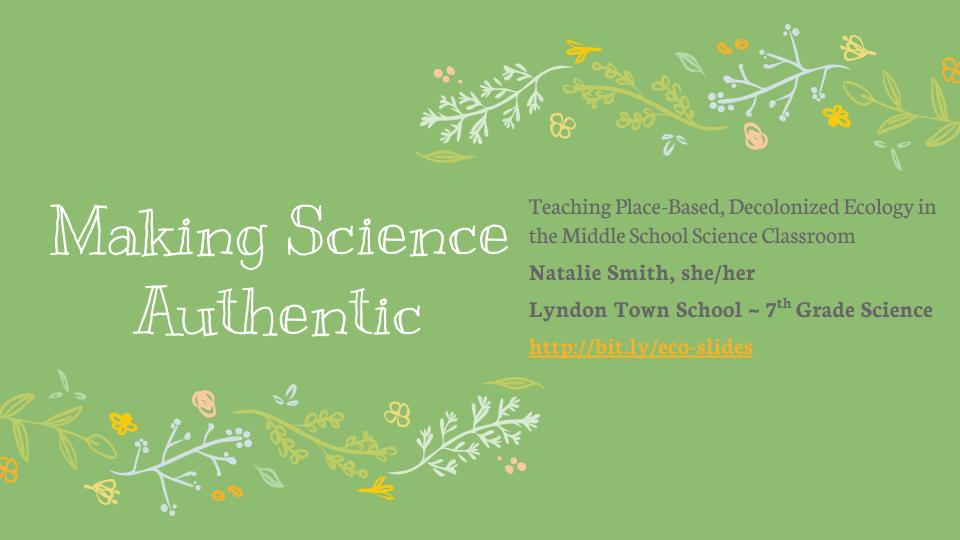
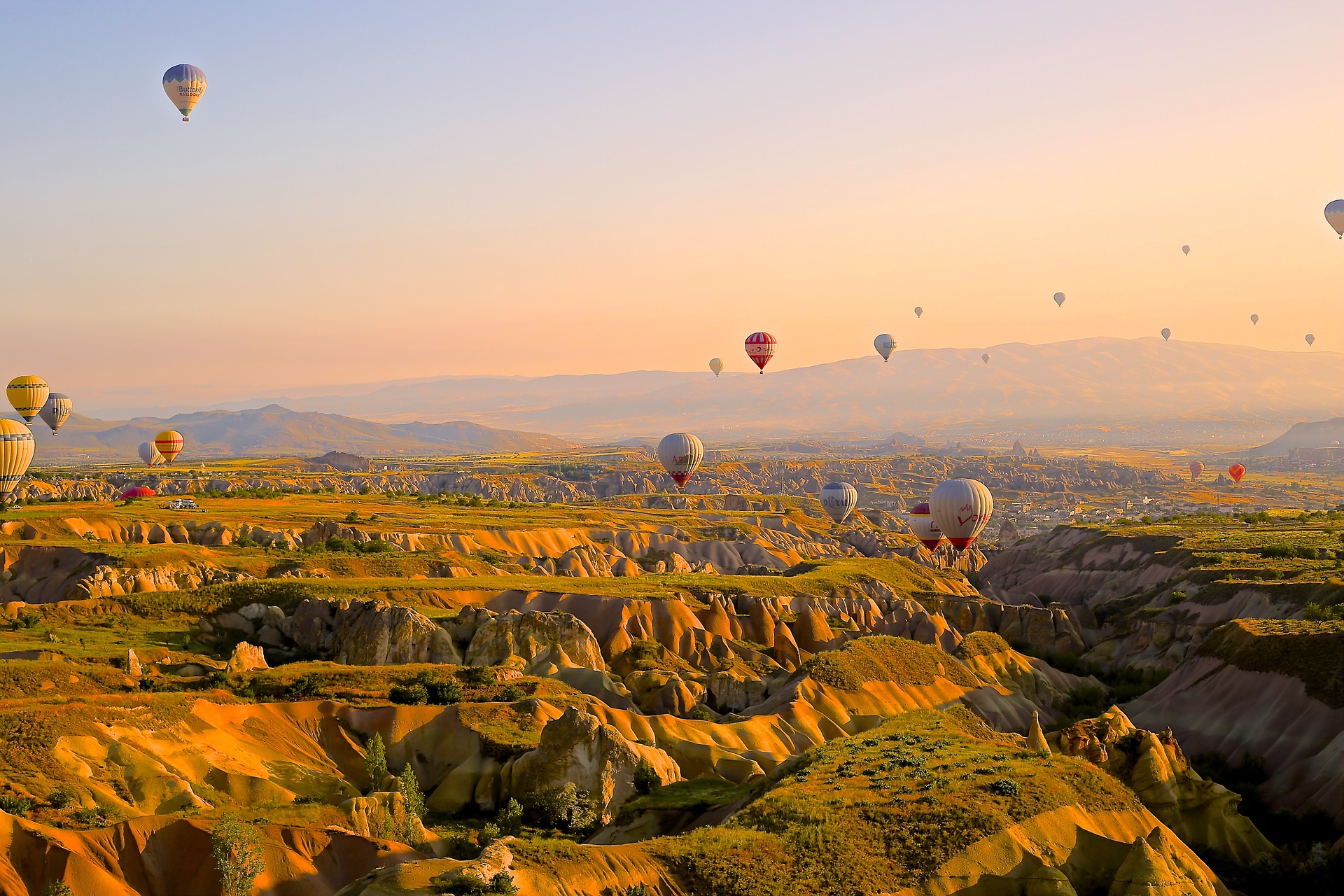
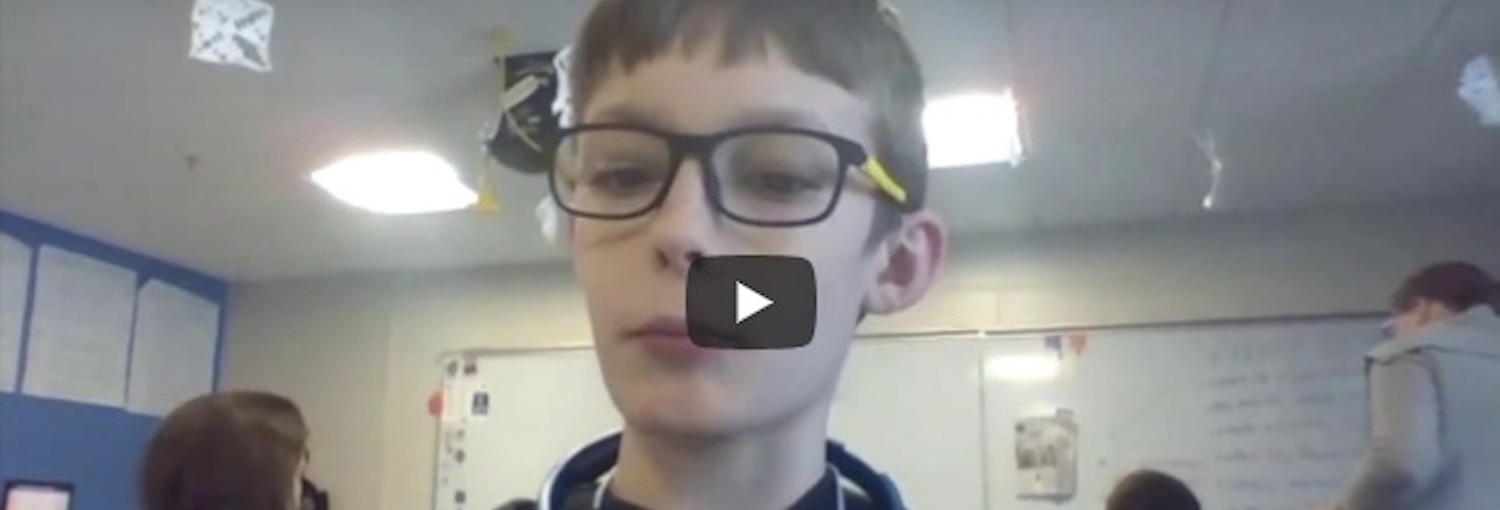
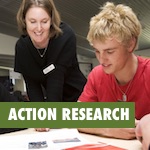
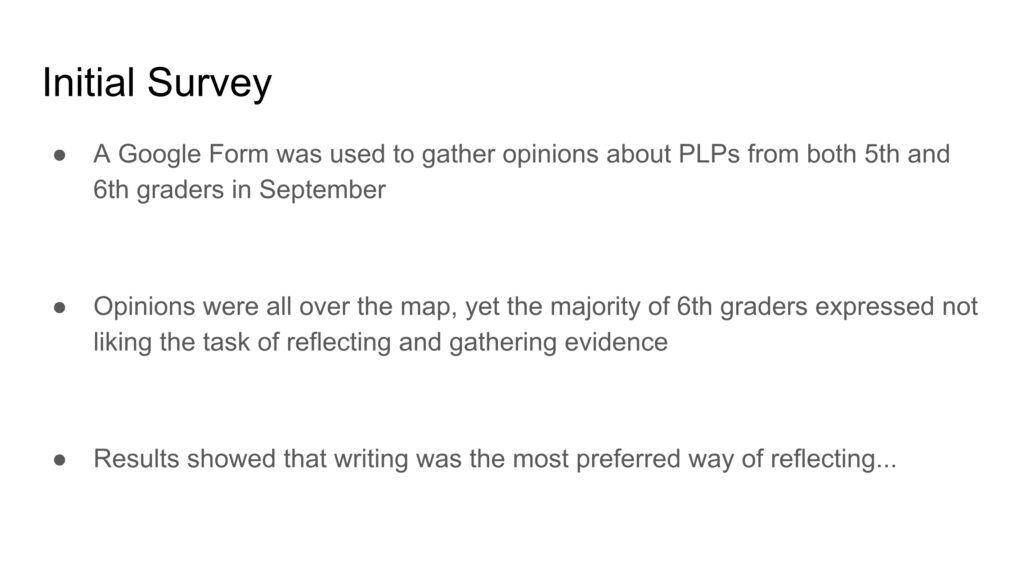
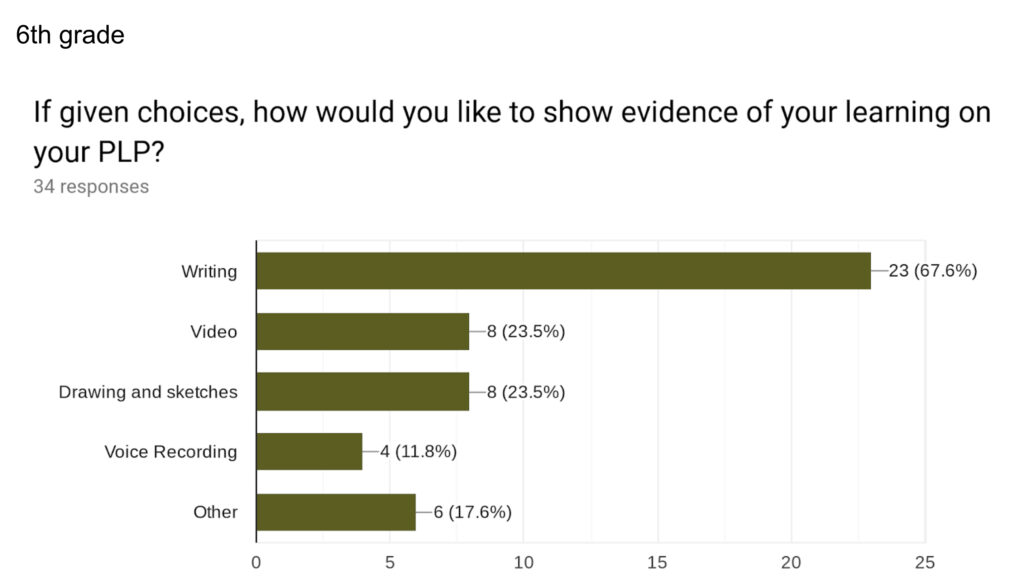
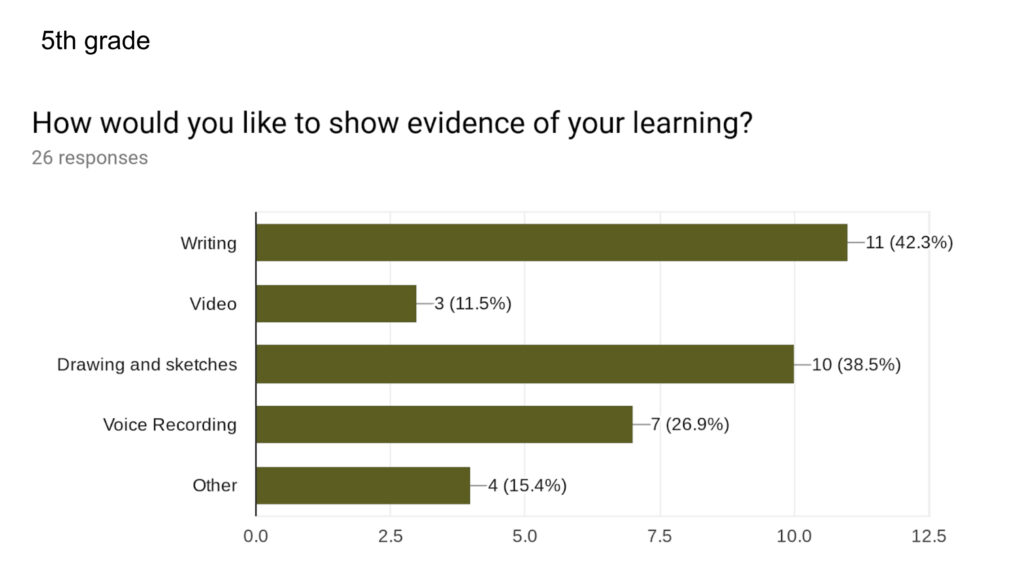
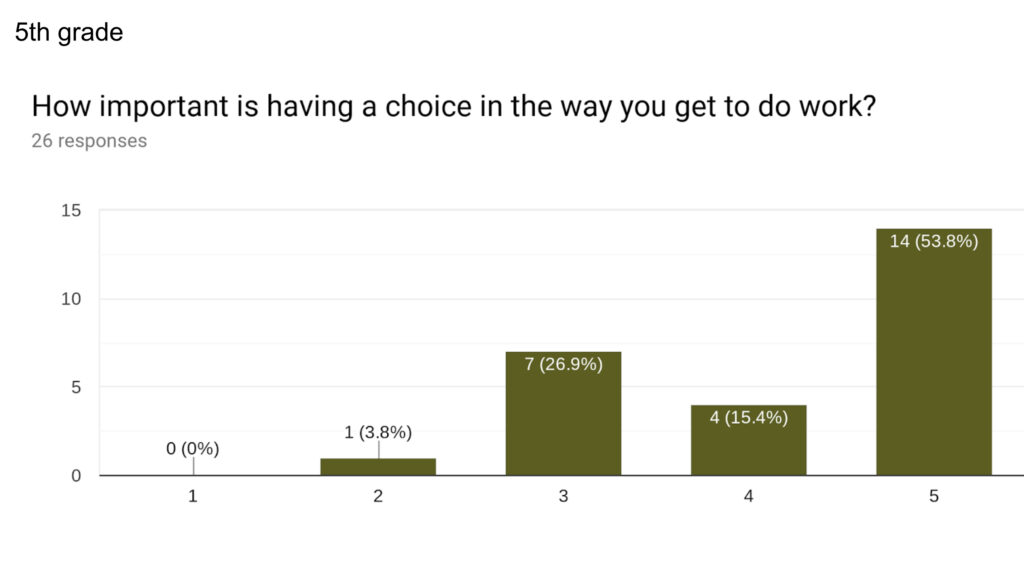
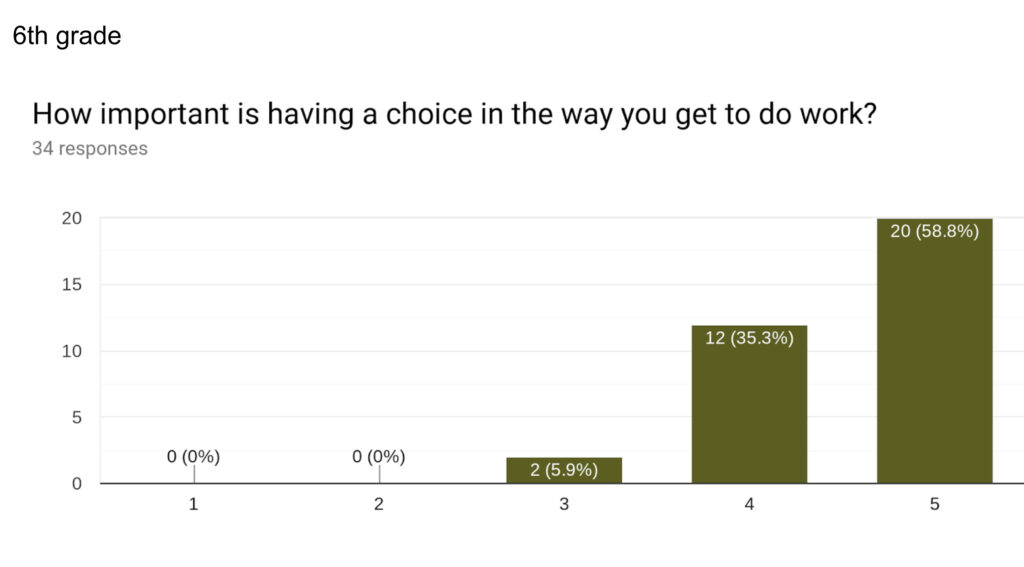
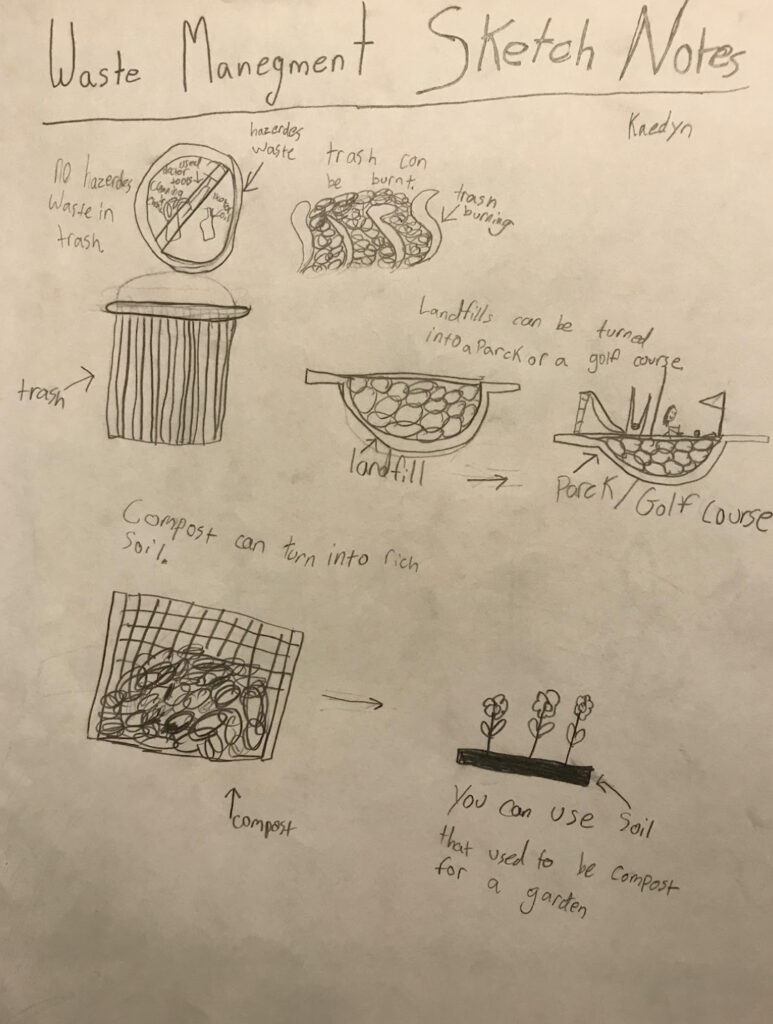
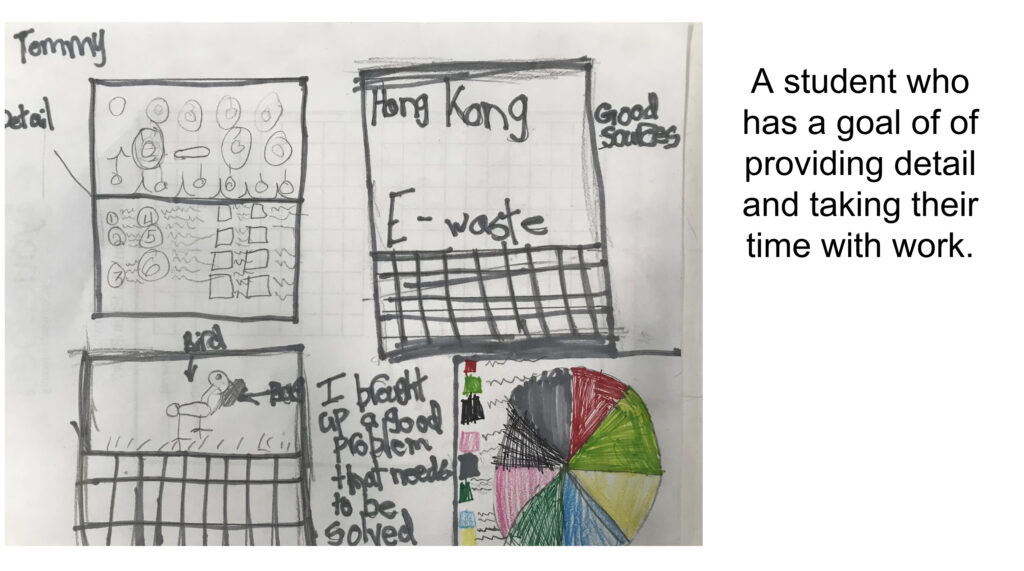
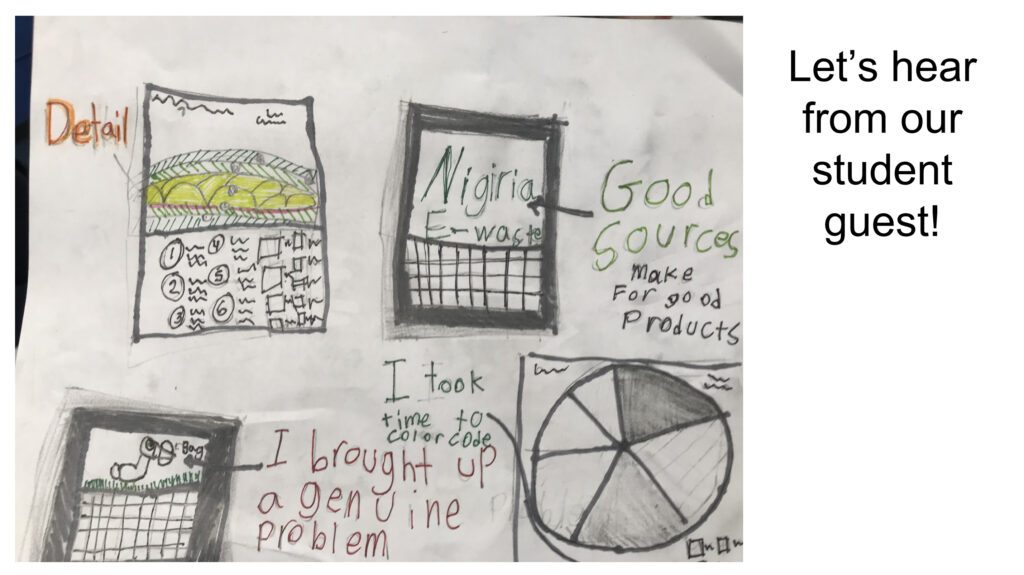 Now, Hudson and his tablemate, Tommy really were two that dove into this idea of being able to use sketchnoting, this idea of visually reflecting. Hudson, what does this show about your work on the integrated unit?
Now, Hudson and his tablemate, Tommy really were two that dove into this idea of being able to use sketchnoting, this idea of visually reflecting. Hudson, what does this show about your work on the integrated unit?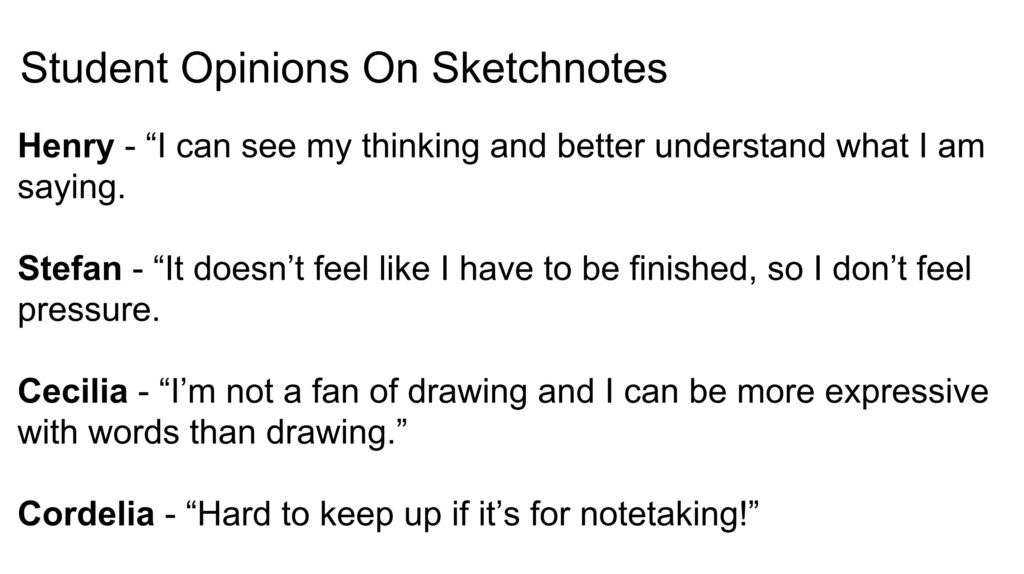
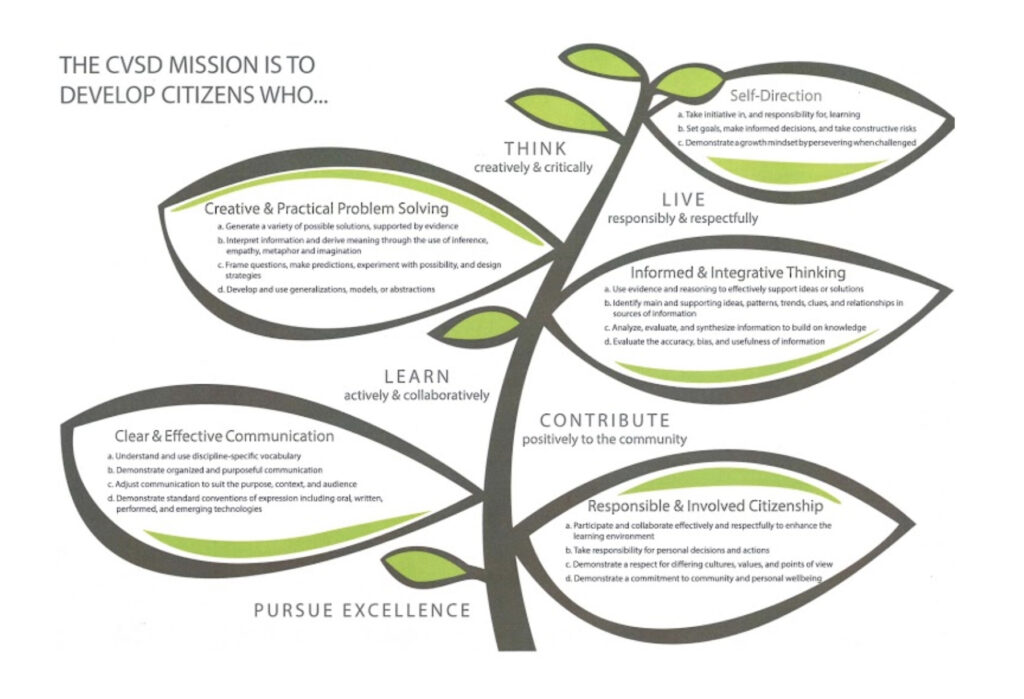
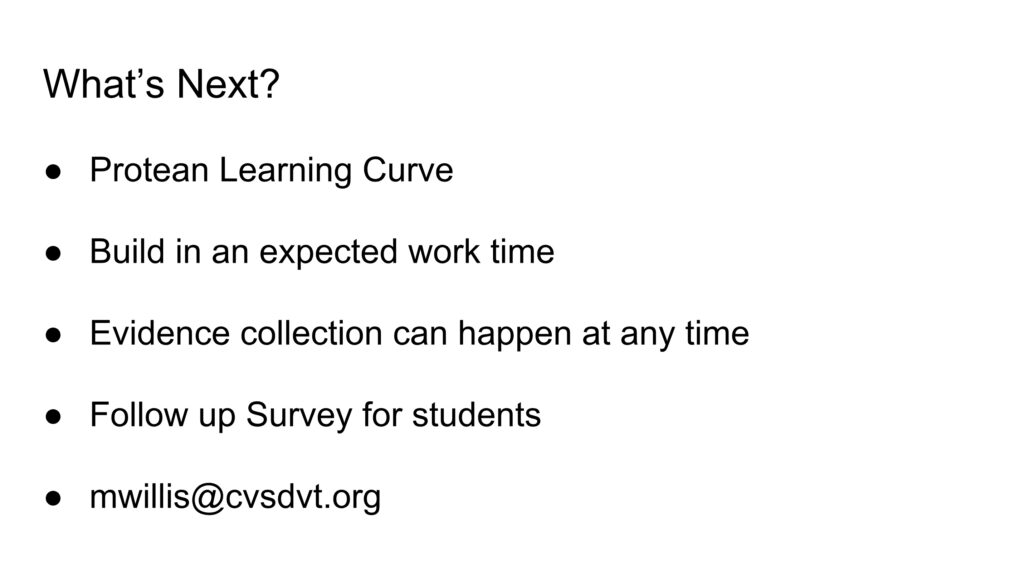 For me, the Protean learning curve is what we all need to keep working on. I think just the micro of it, the minutia of sharing and making it public? Just the pieces of that. As I’ve heard from a lot of workshops, finding more time to do it is tricky, and that’s what makes me think that this evidence collection needs to be able to happen anytime. I’ve yet to really do that as well as I want to. I do want to give an actual survey using Google Forms, but the video feedback is what I use for now. I don’t know if people are familiar with Protean or if you’re using it, but these videos and sketchnotes can be uploaded right into the evidence of a PLP in Protean.
For me, the Protean learning curve is what we all need to keep working on. I think just the micro of it, the minutia of sharing and making it public? Just the pieces of that. As I’ve heard from a lot of workshops, finding more time to do it is tricky, and that’s what makes me think that this evidence collection needs to be able to happen anytime. I’ve yet to really do that as well as I want to. I do want to give an actual survey using Google Forms, but the video feedback is what I use for now. I don’t know if people are familiar with Protean or if you’re using it, but these videos and sketchnotes can be uploaded right into the evidence of a PLP in Protean.